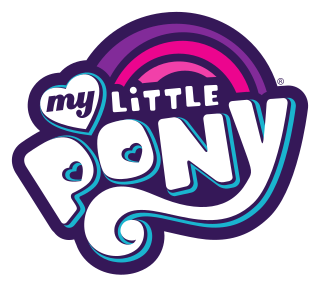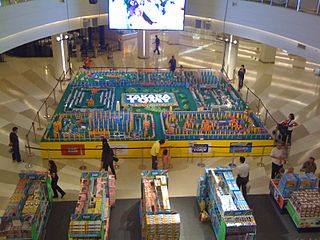
Teletubbies is a British pre-school children's television series created by Ragdoll Productions' Anne Wood and Andrew Davenport. The programme focuses on four multi-coloured creatures known as "Teletubbies", named after the television screens implanted in their abdomens. Recognised throughout popular culture for the uniquely shaped antenna protruding from the head of each character, the Teletubbies communicate through gibberish and were designed to bear resemblance to toddlers.

Cabbage Patch Kids are a line of soft sculptured toy doll like creatures sold by Xavier Roberts and registered in the United States copyright office in 1978.

Hasbro Interactive was an American video game production and publishing subsidiary of Hasbro, the large game and toy company. Several of its studios were closed in early 2000 and most of its properties were sold to Infogrames which completed its studio's closures in 2001.

Parker Brothers was an American toy and game manufacturer which later became a brand of Hasbro. More than 1,800 games were published under the Parker Brothers name since 1883. Among its products were Monopoly, Cluedo, Sorry!, Risk, Trivial Pursuit, Ouija, Aggravation, Bop It, and Probe. The trade name became defunct with former products being marketed under the "Hasbro Gaming" label. However, in 2017, Hasbro revived the brand with the release of several new games which bear similarities with those of some of its previous better well known products.

Play-Doh is a modeling compound used by young children for arts and crafts projects at home. It is composed of flour, water, salt, borax, and mineral oil. The product was first manufactured in Cincinnati, Ohio, United States, as a wallpaper cleaner in the 1930s. The product was reworked and marketed to Cincinnati schools in the mid-1950s. Play-Doh was demonstrated at an educational convention in 1956 and prominent department stores opened retail accounts. Advertisements promoting Play-Doh on influential children's television shows in 1957 furthered the product's sales. Since its launch on the toy market in the mid-1950s, Play-Doh has generated a considerable amount of ancillary merchandise such as The Fun Factory. In 2003, the Toy Industry Association named Play-Doh in its "Century of Toys List".

My Little Pony is a toy line and media franchise mainly targeting girls, developed by American toy company Hasbro. The first toys were developed by Bonnie Zacherle, Charles Muenchinger, and Steve D'Aguanno, and were produced in 1981. The ponies feature colorful bodies, manes and a unique symbol on one or both sides of their flanks. Such symbols are referred to in the two most recent incarnations as "cutie marks". My Little Pony has been revamped several times with new and more modern looks to appeal to a new market.
Kenner Products was an American toy company founded in 1946. Throughout its history the Kenner brand produced several highly recognizable toys and merchandise lines, including action figures like the original series of Star Wars and Jurassic Park, as well as die cast models. The company was closed by its corporate parent Hasbro in 2000.

Tonka is an American producer of toy trucks. Maisto International, which makes diecast vehicles, acquired the rights to use the Tonka name in a line of 1:64 scale diecast vehicles, featuring mostly trucks.

Nerf is a toy brand created by Parker Brothers and currently owned by Hasbro. Most of the toys are a variety of foam-based weaponry, with other Nerf products including balls for sports like American football, basketball and baseball. The most notable of the toys are the dart guns that shoot ammunition made from Nerf foam. Since many such items were released during the 1970s, Nerf products often feature bright neon colors and soft textures similar to the flagship Nerf ball. The slogan, which has been frequently used since advertising in the 1990s, is "It's Nerf or Nothin'!". Annual revenues under the Nerf brand are approximately US$400 million.

Takara Co., Ltd. (株式会社タカラ) was a Japanese toy company founded in 1955. In March 2006, the company merged with Tomy company limited to form Takara Tomy. The Takara motto was 遊びは文化」("playing is culture").

Lewis Galoob Toys, Inc. was a toy company headquartered in South San Francisco, California. They are perhaps best known for creating Micro Machines and distributing the Game Genie in the United States.

Glo Worm is a stuffed toy for young children, designed by Hasbro's Playskool division, and made in Pawtucket, Rhode Island. Introduced in 1982, the plush, pajamaed worm body contained a battery-powered device that when squeezed would light up the toy's vinyl head from within, creating a soft glow.
GoBots is a line of transforming robot toys produced by Tonka from 1983 to 1987, similar to Transformers. Although initially a separate and competing franchise, Tonka's Gobots became the intellectual property of Hasbro after their buyout of Tonka in 1991. Subsequently, the universe depicted in the animated series Challenge of the GoBots and follow-up film GoBots: Battle of the Rock Lords was established as an alternate universe within the Transformers franchise. While Hasbro now owns the fictional side of the property, the actual toys and their likenesses were only licensed from Bandai in the 1980s, were not covered by the Tonka acquisition, and are not available for Hasbro use.

Tomy Company, Ltd. is a Japanese entertainment company that makes children's toys and merchandise. It was created from a merger on 1 March 2006 of two companies: Tomy and long-time rival Takara. The company has its headquarters in Katsushika, Tokyo.
Palitoy was a British toy company. It manufactured some of the most popular toys in Britain, some original items and others under licence. Its products included Action Man, Action Girl, Action Force, Tiny Tears, Pippa, Tressy, Mainline Model Railways, Merlin, Star Wars figures, Play-Doh and the Care Bears.
Rainbow Crafts Company, Inc. or, Rainbow Crafts was a toy manufacturing company created and operated by Noah McVicker and his nephew Joseph McVicker as a subsidiary of the midwestern soap company, Kutol Products. The company manufactured Play-Doh, a modeling compound for children. Rainbow Crafts operated under the McVickers from 1956 until 1965 when it was sold to General Mills with all rights to Play-Doh. In 1971, Rainbow Crafts and Kenner Products merged, and, in 1987, Tonka Corporation bought both subsidiaries. Hasbro currently manufactures Play-Doh.
Bonnie D. Zacherle is an American illustrator and designer who now resides in Warrenton, Virginia. Zacherle is best known as the original creator of the best-selling My Little Pony toy line. She is also the creator of Nerfuls. Zacherle has done some outside consulting for Bliss House, an American licensing consultancy, on the graphics and product development side. In 2003, she became a member of 'Women In Toys'.
Talk 'n Play was an American interactive desktop educational toy book reader with a built in microphone and action buttons that was sold from 1983 to 1992 as an entertaining and educational toy manufactured by CBS Toys, Hasbro, and Kiddesigns. It appears to work utilizing the two sets of right/left tracts to have the "interactive" mono audio segments. It then also provided a record capability so as a child could ad in their own voice and create interactions with characters on the program. It was invented and Patented by Michael J. Freeman Ph.D. and licensed for use by the Children's Television Workshop and the Walt Disney Company, among others. Similar to adapted 4 channels of educational information to produce interactivity, but the main voices were created and produced by Sesame Street and Disney characters under License. Because the toy contained an integrative book reader, some considered it an early lower tech version of the kindle. Talk'N play would say turn the page now. Story programs were produced by others Talk'N Play had many music programs where children could add in or take out, different instruments as the song is played.

Toy Biz was an American toy company, a subsidiary of Marvel Entertainment, best known for producing toys, mainly action figures of licensed brands and characters.

















